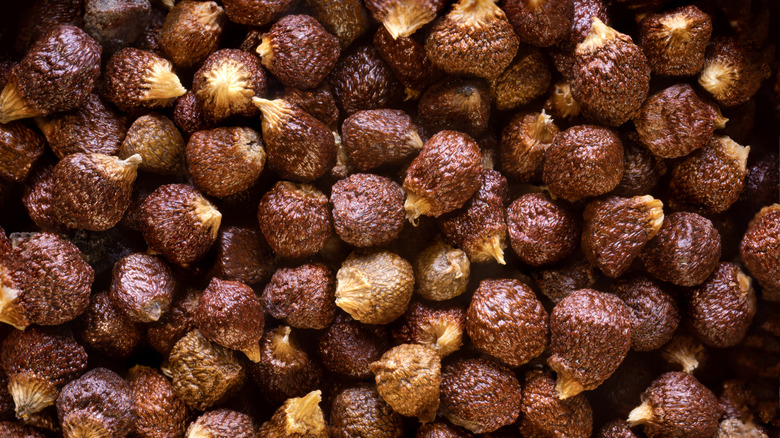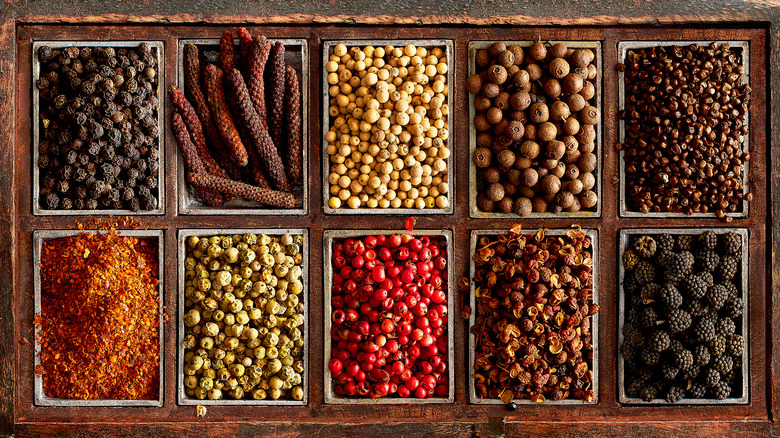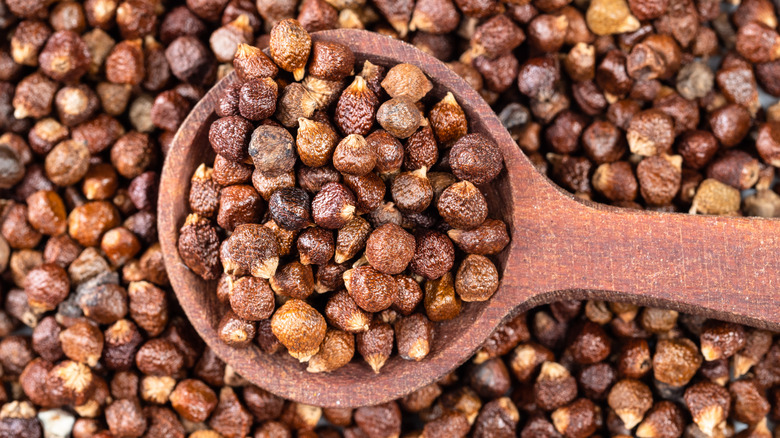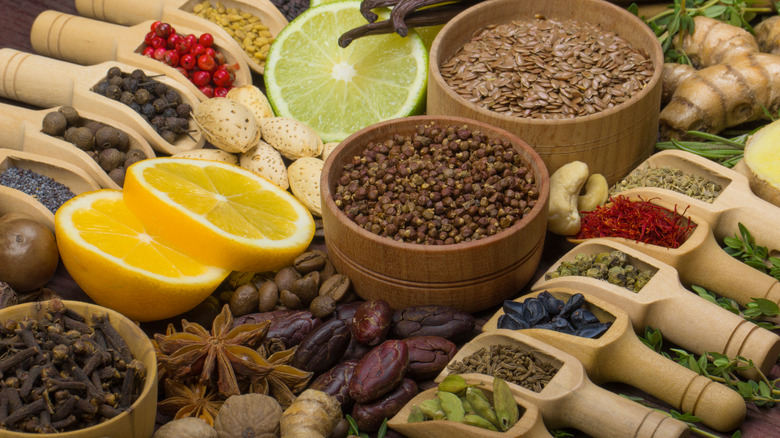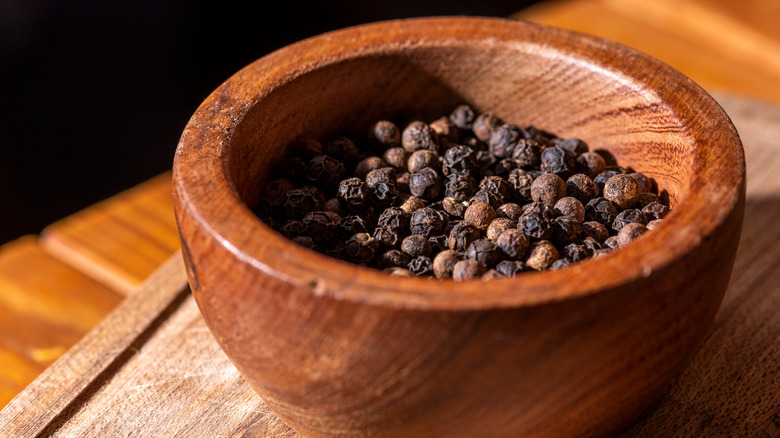Everything You Need To Know About Grains Of Paradise
In a 2000 piece for The New York Times, food writer Amanda Hesser wrote in glowing terms about a spice called grains of paradise, saying it was the spice peppercorns could "only dream of being." To describe it, Hesser said grains of paradise reminded her of "jasmine, hazelnut, butter and citrus" — quite a lot for such a small size.
Such is the spice known as grains of paradise, which has experienced a niche surge in popularity among culinary communities, and for good reason. Grains of paradise is a wonderfully subtle departure from the typical spices found in Western foods and it's so very easy to test and very tasty to use.
As versatile as any other aromatic and easier to find than you would think, these spiced seasonings are used in all kinds of food and drink and are even sometimes used in essential oils. Let's dive into what makes grains of paradise so remarkable and perhaps understand how it earned its heavenly moniker.
The history of grains of paradise
Native to West and North Africa, grains of paradise feature heavily and to delectable effect in much of these regions' cuisine. Roman author Pliny the Elder mentioned the spice in his writings referring to it as "African pepper" (via Right for Education). According to Daniel F. Austin, in his book, "Florida Ethnobotany," the first European mention of grains of paradise came later around the 14th century during which the spice came to find explosive popularity within high society, particularly in Spain and Portugal, and served as yet another imperialistic drive for European countries.
It was and is still grown as a cash group in countries such as Ethiopia, to be shipped all around the world. The stretch of coast where it was grown was dubbed the Pepper Coast, mostly due to the grains of paradise (via Google Arts & Culture). Colonization of the new world saw successful cultivation of grains of paradise in certain regions in Central America and the Mediterranean.
It was during this time that grains of paradise itself got its name, and soon it was considered an equivalent or even better to traditional pepper; many herbalists of the time even claimed grains of paradise had healing and wellness properties — though these were less than scientifically sound claims. By the 18th century its popularity had waned, per Culinary Lore, leaving grains of paradise in the back of the historical spice cabinet until a few centuries later.
How is grains of paradise harvested?
Known by many names and often colloquially confused with other spices, Aframomum melegueta is known correctly by the names: grains of paradise, melegueta pepper, guinea grains, ossame, and efom wisa, according to The Spruce Eats and Aftrad Village Kitchen. It is in the ginger family or Zingiberaceae family of plants (via Britannica) and is closely related in tastes and aromas to other members of its taxonomic family, particularly cardamom. As Tropical Diversity explains, the grains of paradise spice is often confused with alligator pepper, which while an equally colorful name, is an entirely different spice that is also popular in West Africa.
Aframomum melegueta is a swamp loving plant that grows in the unique biomes of Western and Northern Africa, sporting beautiful purple trumpeted flowers with pinkish-orange accents that develop into little brown reddish seed pods as they dry. These seed pods when harvested and further dried hold the grains of paradise, which measure about ⅛-inch in diameter, per The Spruce Eats. Both the seeds inside and the pods that hold them are used for cooking, although, just like for cardamom, the pods are rarely actively consumed.
How to use grains of paradise in cooking
According to The Spruce Eats, grains of paradise were used in the production of European beers and wines until around the 19th century, and it is still used to this day in the production of the signature Scandinavian spirit aquavit.
Grains of paradise look just like peppercorns but with a light reddish-brown hue and more fragrant aromas. As a member of the same family as ginger and cardamom, it can be used to enhance both savory and sweet flavors. The taste is similar to that of pepper but with more earthy overtones and citrus undertones, and as a result. can be used as a more festive substitute for pepper, and pairs particularly well with other spices like cinnamon, cardamom, and other ginger family spices.
You can obtain some seed pods of grains of paradise at most supermarkets or through an online market, and use them the same ways as pepper and cardamom. To use both the seeds and the pods as an aromatic, just lightly crush the seed pods and toss a few into cooking rice, stews, or stir-fries to impart some spicy sweetness.
Grains of paradise as a remedy?
Some of the popularity of grains of paradise — from antiquity and even today — seems to be due to its supposed health benefits and aphrodisiac qualities. Unfortunately there has been little to no scientific evidence to support these claims. Perhaps a carryover from more ancient times or perhaps just a result of more modern obsessions, grains of paradise have garnered a reputation as an ultra-healthy remedy for all sorts of ailments and conditions, per Tropical Diversity, despite the lack of evidence.
According to WebMD, there may be some chemical compounds present in grains of paradise that tend to reduce inflammation and may help to burn fat, but the evidence is sparse and no connection has been formally made.
This said, though they may not be a super-health-food or a powerful aphrodisiac, grains of paradise still offer a new way of adding more nuanced tones into food and are absolutely worth trying in your next chai tea, fried rice, or apple pie.
